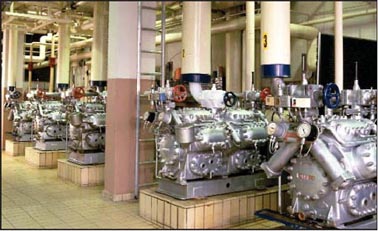Ammonia's one drawback is that in quantities much larger than a "sniff" it is poisonous. It dissolves in water, including the water in our lungs, to form a strong base (alkali), ammonium hydroxide. It is also corrosive. Wherever ammonia is used in bulk, including for refrigeration, careful precautions must be taken to educate and safeguard people in the area.
With proper precautions, though, the benefits of ammonia are compelling, and so it continues to be the refrigerant of choice for large storage applications. It is inexpensive - at about $0.25 per pound, it is as much as 25 times less expensive than alternative refrigerants, and the price is very stable. Because ammonia is denser than fluorinated refrigerants, a comparatively much smaller quantity is needed for a facility of a given size, and piping is smaller. The piping is steel, much less expensive than the copper used for other commercial refrigerants (although joining the pipe requires welding rather than the less costly brazing used with copper). Ammonia's distinctive odor makes it self-alarming when a leak occurs.
The most prevalent use of ammonia today is in cold storage warehouses and in dairy and food processing plants. Danfoss is one of the principal suppliers of industrial refrigeration components for these facilities.

Sensor Alerts Reduce Dangers
In earlier days, because ammonia was cheap, users were not always very aggressive about finding small leaks, which can be a very labor-intensive undertaking. Today, however, social sensitivity and strict regulations require a number of proactive measures to ensure safety.Some measures are simple. Since ammonia is most dangerous in confined areas, relief valves are piped outside. High technology leak detection sensors reveal even the smallest leaks, and tracking devices and sophisticated software track clouds of released ammonia and predict with high accuracy where they will travel. Firemen and other emergency personnel are trained, wherever ammonia systems exist, in the design of each particular system and in how to vent the refrigerant or pump down the system into a remote storage vessel when there is an emergency.
One of the greatest advantages of ammonia as a refrigerant is that it is the only refrigerant commonly used today that is environmentally safe. It quickly "recycles" itself in the atmosphere. It does not react with our planet's ozone layer, so it does not contribute to increased dangerous ultraviolet radiation. And it is not a greenhouse gas that contributes to global warming.
There are dangers inherent in ammonia refrigeration, but they are well compensated for by safety measures, just as are the dangers in air travel and in other conveniences. Because of the great economic advantages of ammonia, goods and services cost consumers less. For that reason, and for the benign environmental aspects of ammonia, its use will not diminish in the foreseeable future, and its application may well increase.
Max Robinson is in Technical Communications at Danfoss Inc. (Baltimore). For more information, visit www.danfoss.com.
Publication date: 10/04/2004

Report Abusive Comment